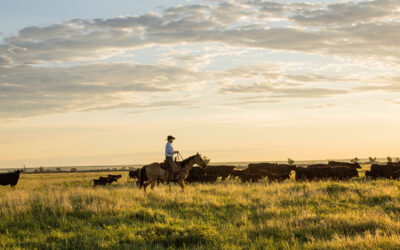
Cattle thriving in the southeast pasture
I remember what green grass looks like
My first day in the area, I heard folks talk about the blessings of rain they’ve had since the first of the January. Needless to say, many of the cattlemen I visited were most proud of their grass, and rightfully so. I mean, look at that grass – I repeat, LOOK at that GRASS!
The combination of rye and rye grass that many rely on for early spring grazing is thriving. Some will eventually be baled; other fields are strictly for pasture. Terry Kirkland of Saluda County, SC, even has some of his cattle on an intensive grazing program using the abundant resources.

Fall calving can fit
The timeline for commercial cattle production in the southeast can be very different from other parts of the country. They’re not shying away from calving in the first four months of the year for fear of frost-bit ears (Did I mention it was in the 70s for the first day of spring in Georgia while it snowed at the CAB office in Ohio?), but rather to get calves developed and weaned, sometimes even sold, before the heat of the summer. I saw a lot of calves that hit the ground between the first of Sept and the end of November. While that may not work for everyone, many producers find a way to make that a profitable age bracket to market calves.
Good genetics go a long way

I saw a total of at least nine different breeds represented in cowherds last week. Many outcrosses were a result of retaining heifers during a transitional time in the herd when maybe there was encouragement to chase a fad, causing some extreme diversity and inconsistencies. How does a smart cow-man increase the quality of his calf crop without liquidating all of Baskin Robbins’ 31 flavors? Breed them to a high-quality registered Angus bull. Retaining the best daughters out of those matings year after year has improved the factory, not to mention the quality of steer calves they turn out.
There’s no substitute for quality and customer service

Don Havird has years of farming success in the peach business. Although that wasn’t why I was there to see him, Don promised that the principles he lived by in peach farming are 100% applicable to how he raises cattle. “You have to sell a premium product at a premium price,” Don says. Raising the same level of quality as every other farmer in the county isn’t good enough, but you also can’t afford to take the same price for them.
Although his humility wouldn’t share it, I later learned second-hand that Don was the first in South Carolina to brand his own peaches long before any of the major produce companies. Don also knows that demanding a higher price comes with obligations to your clientele. “You have to handle your customer with white gloves – very carefully. At the end of the day, they are your most important business partner.”
I don’t know much about peach production, but I think Don could write a page or two for the handbook to raising and marketing cattle above the line of mediocrity.
A big ‘thank you’ goes out to the many cattlemen and women who took time out of their schedules to walk me through their herds last week. Southern hospitality at its finest!
Kara
You may also like
Raised with Respect™ Cattle Care Campaign Launched This Fall
Raised with Respect™ was developed as part of a strategic cattle care partnership between Sysco and CAB. The collaboration focuses on supporting farmers and ranchers, equipping them with continuing education to stay current on best management practices and helping to increase consumer confidence in beef production.
Everything They Have
Progress is a necessity on the Guide Rock, Nebraska, ranch where Troy Anderson manages a commercial Angus herd, small grower yard, his 10-year-old son, and a testing environment. Troy’s approach includes respect for his livestock, people and land. For that, Anderson Cattle was honored with the CAB 2023 Commercial Commitment to Excellence Award.
Making It Better
Most sane folks don’t choose to go into business with Mother Nature. She’s a fickle and unpredictable partner. So, how did two people with zero agricultural background, no generational land, wealth or genetics carve a profitable partnership with her in Southwest Kansas? By focusing on progress and a desire to leave things better than they found them – which also earned them the CAB Sustainability Award.




